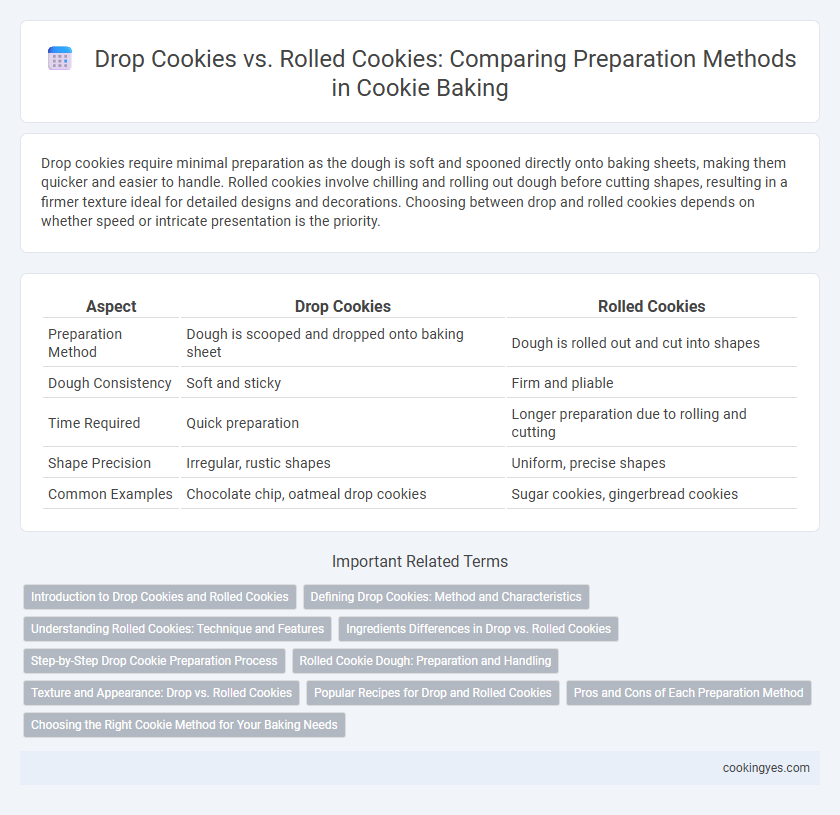Drop cookies require minimal preparation as the dough is soft and spooned directly onto baking sheets, making them quicker and easier to handle. Rolled cookies involve chilling and rolling out dough before cutting shapes, resulting in a firmer texture ideal for detailed designs and decorations. Choosing between drop and rolled cookies depends on whether speed or intricate presentation is the priority.
Table of Comparison
| Aspect | Drop Cookies | Rolled Cookies |
|---|---|---|
| Preparation Method | Dough is scooped and dropped onto baking sheet | Dough is rolled out and cut into shapes |
| Dough Consistency | Soft and sticky | Firm and pliable |
| Time Required | Quick preparation | Longer preparation due to rolling and cutting |
| Shape Precision | Irregular, rustic shapes | Uniform, precise shapes |
| Common Examples | Chocolate chip, oatmeal drop cookies | Sugar cookies, gingerbread cookies |
Introduction to Drop Cookies and Rolled Cookies
Drop cookies are made by scooping spoonfuls of soft dough directly onto the baking sheet, resulting in a casual, irregular shape often seen in chocolate chip or oatmeal cookies. Rolled cookies require a firmer dough that is chilled, rolled out flat, and cut into precise shapes before baking, commonly used for sugar cookies or gingerbread. The preparation method directly impacts the texture, with drop cookies being softer and chewier, while rolled cookies tend to be crisper and more uniform.
Defining Drop Cookies: Method and Characteristics
Drop cookies are made by dropping spoonfuls of soft dough directly onto a baking sheet, resulting in a rustic, uneven shape. They typically have a moist, chewy texture due to their higher moisture content and shorter spreading time during baking. Common examples include chocolate chip and oatmeal cookies, which rely on minimal handling for easy preparation and distinct chunk distribution.
Understanding Rolled Cookies: Technique and Features
Rolled cookies require dough to be chilled and rolled out evenly before cutting shapes with cookie cutters, ensuring consistent thickness and uniform baking. The technique emphasizes precise dough handling and surface flouring to prevent sticking while preserving dough texture. This preparation method results in elegant, thin cookies with defined edges, ideal for detailed decoration and festive presentation.
Ingredients Differences in Drop vs. Rolled Cookies
Drop cookies typically use a higher ratio of baking soda or baking powder and contain more liquid ingredients like eggs and butter to create a softer, spreadable dough, while rolled cookies have a stiffer dough with less leavening and moisture to maintain shape during rolling and cutting. The sugar content in rolled cookies is often higher to promote crispness, whereas drop cookies favor a balance that supports a chewy texture. The flour amount in rolled cookies is generally greater to ensure dough firmness, contrasting with the looser consistency of drop cookie dough.
Step-by-Step Drop Cookie Preparation Process
Drop cookies require a straightforward preparation where the dough is mixed until just combined, then portions of dough are dropped by spoonfuls onto a baking sheet without the need for chilling or rolling. The step-by-step process begins with creaming butter and sugar, followed by incorporating eggs and dry ingredients to form a soft, sticky dough that holds shape when scooped. Baking times are typically shorter, about 8-12 minutes at 350degF (175degC), resulting in a tender, textured cookie with a rustic appearance.
Rolled Cookie Dough: Preparation and Handling
Rolled cookie dough requires precise chilling to achieve the perfect firmness for rolling without sticking or cracking, making temperature control crucial in preparation. Proper flour measurement and gentle handling preserve dough consistency, ensuring even thickness and uniform baking. Using parchment paper or silicone mats during rolling prevents sticking and facilitates easy transfer of cut shapes to baking sheets.
Texture and Appearance: Drop vs. Rolled Cookies
Drop cookies have a rustic, irregular shape and a chewy, soft texture due to their thick, sticky dough that is spooned onto the baking sheet. Rolled cookies are thinner, with a smooth, even surface and crisp edges, achieved by rolling out the dough and cutting it into precise shapes before baking. The difference in preparation directly influences drop cookies' tender chewiness and rolled cookies' firm, crunchy bite and classic decorative appearance.
Popular Recipes for Drop and Rolled Cookies
Drop cookies, such as chocolate chip and oatmeal raisin, are popular for their ease of preparation, involving dropping spoonfuls of dough onto a baking sheet. Rolled cookies, including classic sugar cookies and gingerbread, require rolling out the dough and cutting shapes before baking, allowing for decorative designs. Both methods yield distinct textures and appearances, with drop cookies typically softer and thicker while rolled cookies offer a firmer bite and intricate shapes.
Pros and Cons of Each Preparation Method
Drop cookies require minimal preparation, as the dough is simply dropped onto the baking sheet, saving time and effort; they spread naturally during baking, resulting in a rustic, homemade appearance. Rolled cookies involve chilling and rolling the dough, allowing precise shapes and uniform thickness, which is ideal for decorative or cut-out designs, but this method is more labor-intensive and time-consuming. Drop cookies can produce softer textures, while rolled cookies often yield crisp edges, making the choice dependent on desired texture and aesthetic outcomes.
Choosing the Right Cookie Method for Your Baking Needs
Drop cookies require minimal preparation, as the dough is simply scooped and dropped onto the baking sheet, making them ideal for quick, rustic treats like chocolate chip or oatmeal cookies. Rolled cookies involve chilling and rolling out the dough before cutting shapes, which allows for more intricate designs and uniform thickness, perfect for decorated sugar cookies or festive shapes. Selecting the right method depends on the desired texture, appearance, and time available for baking, with drop cookies offering ease and chewiness, while rolled cookies provide precision and a crisp finish.
Drop cookies vs Rolled cookies for preparation method Infographic

 cookingyes.com
cookingyes.com